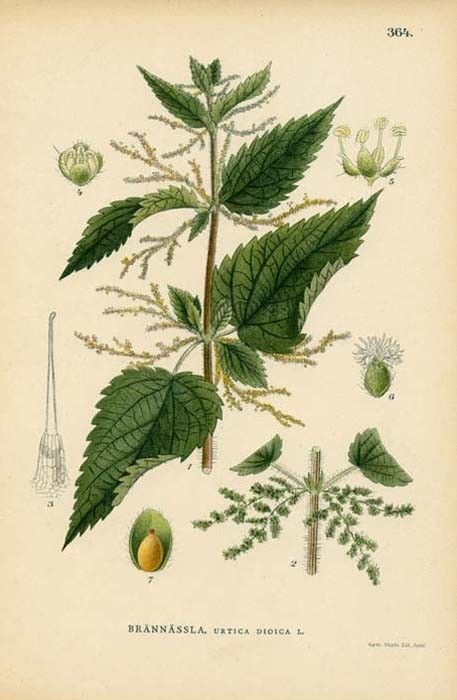 Also Known As:
Also Known As:
Common Nettle, Nettle Leaf, Urtica.
Scientific Name:
Urtica dioica;
Family: Urticaceae.
People Use This For:
Stinging nettle above ground parts is used for allergies, allergic rhinitis, and musculoskeletal disease such as osteoarthritis. It is also used orally in conjunction with copious fluid intake in so-called "irrigation therapy" for urinary tract infections, urinary tract inflammation, and kidney stones. People also use the above ground parts of stinging nettle for internal bleeding, including uterine bleeding, epistaxis, and melena; anemia; poor circulation; splenomegaly; diabetes and other endocrine disorders; gastric hyperacidity; biliary complaints; diarrhea and dysentery; asthma; pulmonary congestion; rash and eczema; cancer; prevention of signs of aging; blood purification; wound healing; and as a general tonic.
In foods, young stinging nettle leaves are eaten as a cooked vegetable.
In manufacturing, stinging nettle extract is used as an ingredient in hair and skin products.
Safety:
No concerns regarding safety when used orally and appropriately.
Pregnancy and Lactation: Refer to a Medical Herbalist.
Effectiveness:
INSUFFICIENT RELIABLE EVIDENCE to RATE
Allergic rhinitis (hayfever). There is preliminary evidence that stinging nettle above ground parts might improve symptoms of allergic rhinitis. Starting stinging nettle at the first sign of symptoms seems to provide subjective improvement.22
Osteoarthritis. There is evidence that oral or topical use of stinging nettle leaf extract might improve symptoms of pain in patients with osteoarthritis.23,24 Some clinicians use stinging nettle leaf extract in combination with conventional nonsteroidal anti-inflammatory drugs (NSAIDs) or other analgesics. Evidence suggests that adding stinging nettle might allow for using lower analgesic doses in some patients.24 Topically, stinging nettle leaf seems to improve pain and disability in patients with osteoarthritis of the thumb, according to preliminary research.25
More evidence would be helpful to rate stinging nettle for these uses.
Mechanism of Action:
The applicable parts of stinging nettle are the above ground parts.
Stinging nettle leaves contain several nutrients and active constituents. The leaves are eaten as a food because of significant amounts carotene, vitamin C, vitamin K, potassium, and calcium.26,27,28,29 There is about as much vitamin C and carotene in stinging nettle leaves as in spinach and other greens.30 The leaves also contain beta-sitosterol and the flavonoids quercetin, rutin, kaempferol, and others. Stinging nettle tops seems to have a variety of pharmacological effects including analgesic,23,31 anti-inflammatory,29 local anesthetic,23 hemostatic,31 antibacterial,28 and antiviral.32
For osteoarthritis and other musculoskeletal conditions, stinging nettle above ground parts might work due to potential analgesic and anti-inflammatory effects.24,25
Some researchers think that stinging nettle might be beneficial for allergic rhinitis due to quercetin content. Quercetin is thought to have anti-inflammatory and mast-cell stabilizing effects. It decreases histamine release from basophils and mast cells.33
Stinging nettle seems to also act as a diuretic. The leaf juice can increase urine output and slightly decrease systolic blood pressure and body weight in people with venous insufficiency.23,28 Because of these effects, some people use stinging nettle for urinary tract disorders, including urinary tract infections (UTIs) and kidney stones. Stinging nettle also seems to decrease blood pressure and heart rate.23,31
Adverse Reactions:
Stinging nettle above ground parts is generally well-tolerated.
Interactions with Drugs:
Lithium
Warfarin (Coumadin)
Interactions with Foods:
None known.
Interactions with Lab Tests:
None known.
Interactions with Diseases or Conditions:
Kidney disease.
Dosage/Administration:
Dr Clare’s Blends: 1 gm per day
For osteoarthritis, people typically use crude stinging nettle leaf 9 grams daily.24
For allergic rhinitis, people typically use stinging nettle leaf extract 300 mg three times daily. However, in some cases, 300 mg up to seven times daily has been used.22
Dr Clare’s Comment
Stinging nettle leaf has a long history of use. It was used primarily as a diuretic and laxative as early as the times of the Greek physicians Dioscorides and Galen.
Specific References: STINGING NETTLE
22. Mittman P. Randomized, double-blind study of freeze-dried Urtica dioica in the treatment of allergic rhinitis. Planta Med 1990;56:44-7.
23. Monographs on the medicinal uses of plant drugs. Exeter, UK: European Scientific Co-op Phytother, 1997.
24. Mills S, Bone K. Principles and Practice of Phytotherapy. London: Churchill Livingstone, 2000.
25. Randall C, Randall H, Dobbs F, et al. Randomized controlled trial of nettle sting for treatment of base-of-thumb pain. J R Soc Med 2000;93:305-9.
26. Blumenthal M, ed. The Complete German Commission E Monographs: Therapeutic Guide to Herbal Medicines. Trans. S. Klein. Boston, MA: American Botanical Council, 1998.
27. Wichtl MW. Herbal Drugs and Phytopharmaceuticals. Ed. N.M. Bisset. Stuttgart: Medpharm GmbH Scientific Publishers, 1994.
28. Leung AY, Foster S. Encyclopedia of Common Natural Ingredients Used in Food, Drugs and Cosmetics. 2nd ed. New York, NY: John Wiley & Sons, 1996.
29. Brinker F. Herb Contraindications and Drug Interactions. 2nd ed. Sandy, OR: Eclectic Medical Publications, 1998.
30. Foster S, Tyler VE. Tyler's Honest Herbal: A Sensible Guide to the Use of Herbs and Related Remedies. 3rd ed., Binghamton, NY: Haworth Herbal Press, 1993.
31. Newall CA, Anderson LA, Philpson JD. Herbal Medicine: A Guide for Healthcare Professionals. London, UK: The Pharmaceutical Press, 1996.
32. The Review of Natural Products by Facts and Comparisons. St. Louis, MO: Wolters Kluwer Co., 1999.
33. Anon. Quercetin. Alt Med Rev 1998;3:140-3.

 Also Known As:
Also Known As: